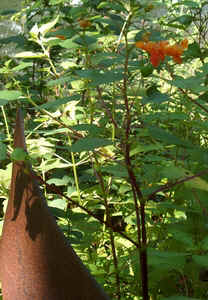 |
Common Name: Jewel Weed, Orange Jewelweed, Spotted Touch-me-Not, Balsam, Brook Celandine, Ear Jewel, Kicking Colt, Silverleaf, Snapdragon, Hummingbird Tree
Scientific Name: Impatiens capensis
Family: Balsaminaceae
Native Annual Herb
Highway 74
Nantahala Gorge, North Carolina
July 30, 2002
 |
A native annual herb very similar to the previous species except for flower color and, usually, a difference in habitat. These plants grow in moist open areas along streams and in acid soils throughout most of North Carolina and the eastern U.S. May - Frost [Justice, William S. and Bell, C. Ritchie, Wild Flowers of North Carolina. University of North Carolina Press, Chapel Hill, 1968]
This succulent plant with simple, round-toothed leaves has unmistakable flowers. Numerous orange, spotted blooms dangle from fine stalks like precious jewels. Orange jewelweed is very similar to pale jewelweed (Impatiens pallida) which grows in the same habitat. Flower coloration is enough to distinguish the two. Hummingbirds, butterflies and bees are attracted to this flower. the circular petals force pollinators to push past either the mature stamens, which deposit white pollen on them, or the small green pistil, which receives pollen. To avoid self-pollination, the flower is first male then female. The name jewelweed refers to the way water beads up on its leaves. June - September [White, Peter, Wildflowers of the Smokies. Great Smoky Mountains Natural History Association, Gatlinburg, 1996]
The orange, crimson-spotted flowers of jewel weed are rich in color, and the leaves sparkle with dew. Sadly, some call it a weed because it self-seeds so vigorously. In moist areas, fields of this watery, hollow-stemmed plant appear as if overnight. It is one of the few annuals covered in this book because it is so common and because it is a nectar plant for hummingbirds. The plant is worth knowing for one other reason: A mash of the leaves and stems will take the itch out of a poison ivy rash. This remedy can be used in the field or at home, and you can freeze the concoction in ice cube trays and have a ready supply of cool comfort in the freezer. The silverleaf's name describes the look of a leaf held under water. A white film covering the leaf seems to repel water. Young shoots of jewel weed can be eaten as a cooked green. [Midgley, Jan. W., Southeastern Wildflowers. Cranehill Publishers, Hong Kong, 1999]
January February March April May June July August September October November December
Alphabetical Listings -- A B C D, E F G H I, J, K L M N, O P Q, R S T U, V W X, Y, Z
Family Listings -- A B C D, E F G H I, J, K L M N, O P Q, R S T U, V W X, Y, Z
Genus Listings -- A B C D, E F G H I, J, K L M N, O P Q, R S T U, V W X, Y, Z